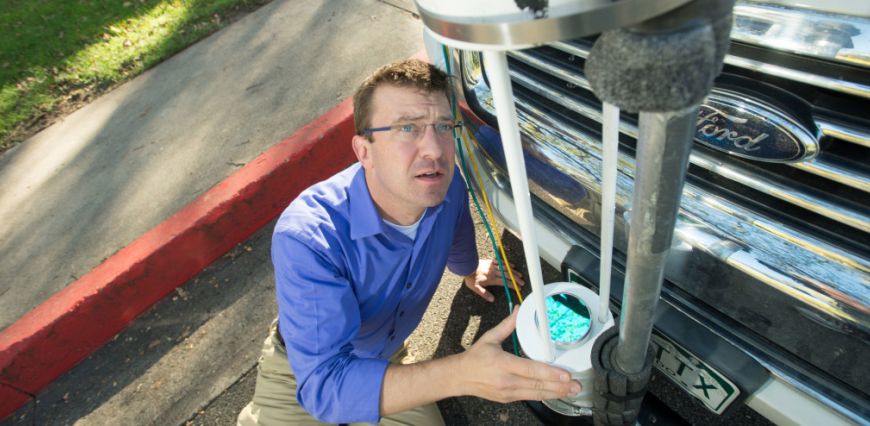
Joe von Fischer with a laser-based methane analyzer attached to a CSU research vehicle. The setup is similar to the Google Street View cars used to study methane leaks in major cities. Credit: John Eisele, Colorado State University
The state of New Jersey’s largest utility provider has some leaky pipes, which they’ll soon fix to the tune of a $905 million infrastructure upgrade.
This massive improvement plan is one based in science that originated at Colorado State University. A team headed by Joe von Fischer, associate professor in the College of Natural Sciences’ Department of Biology, has led the charge to identify and quantify methane leaks in natural gas pipelines crisscrossing several U.S. cities.
New Jersey’s Public Service Electric and Gas Company (PSE&G) is set to modernize 510 miles of gas mains and 38,000 service lines, in large part motivated by the work of von Fischer and collaborators: research associate Adam Gaylord, and Jay Ham, professor of environmental physics and micrometeorology in the College of Agricultural Sciences.
EDF-sponsored methane studies
A few years ago, the Environmental Defense Fund (EDF) commissioned a series of studies – three led by CSU researchers – to expose the problem of fugitive methane emissions from the natural gas supply chain. One of the experts they tapped was von Fischer, an ecosystem ecologist who had previously studied greenhouse gas emissions in undisturbed ecosystems (never cities). Von Fischer’s lab already had a laser-based methane analyzer that they had rigged to a car for real-time methane measurements. It was a perfect match of interests.
Partnering with Google Street View
To collect the data, Google Street View cars were equipped with methane sensors for detecting leaks in the miles of underground natural gas pipelines in different cities. The publicly available results include interactive mapping of the methane leaks. The ultimate goal: helping utilities make informed decisions on how best to prioritize and repair their leaks.
Armed with the CSU team’s data, EDF participated in negotiations leading to PSE&G’s infrastructure improvement plan. The data allowed PSE&G to prioritize their plan in a systematic way, by tackling the leaks that have the largest climate and economic impacts.
“Until this project, there was no fast, economical way to determine leak size,” von Fischer said. “Our science has delivered a tool that allows us to rapidly survey for both leak location and leak magnitude. Now we’re eager for it to be applied more broadly.”
Pulling together industry, academia
The project pulled together university, nonprofit and industry leadership.
“Methane is the main ingredient in natural gas, and a highly potent greenhouse gas,” said Jonathan Peress, EDF air policy director for natural gas. “PSE&G is the first gas utility to provide extensive information to EDF on its existing gas system, and on its method of targeting mains for replacement. The utility’s willingness and commitment to actively participate in our survey program enabled us to focus our work so that PSE&G is able to use methane emissions data for its gas infrastructure upgrades.”
The work is continuing to map more cities and improve the modeling. The team has recently added Sangmi Pallickara, assistant professor of computer science, whose team is building a software system for managing millions of methane mapping data points generated from this project.